Acrylic paints for drawing have recently gained popularity. A big role was played by the fact that they are quite easy to use, and the drawings, whether on canvas, wood or stones, turn out very beautiful.
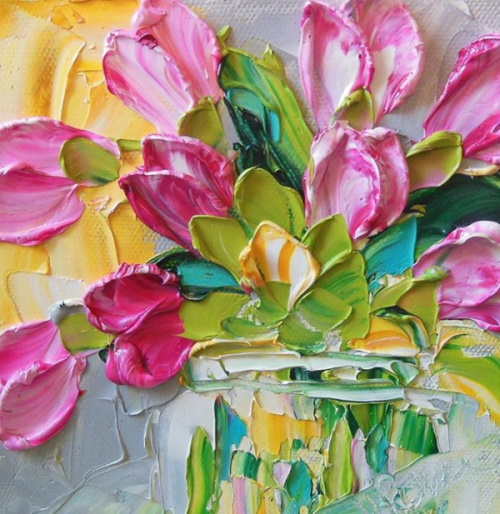
Acrylic - quick drying a material that forms a waterproof coatingAn interesting property of such paints is their versatility in application.
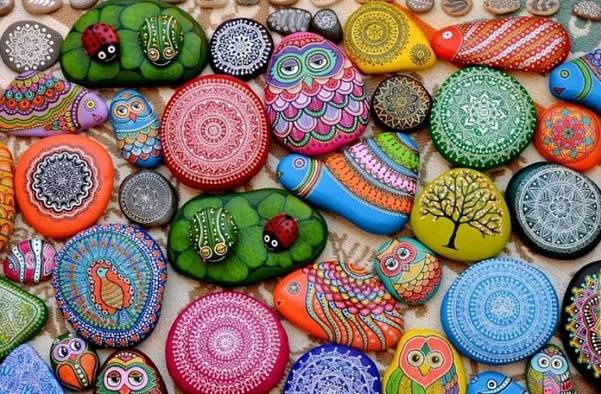
Due to their brightness and ease of use, they can be used to create a variety of effects and visual textures on a wide range of surfaces, including interior and exterior construction work.
Advantages and disadvantages of acrylic paints when painting on different surfaces
Working with acrylic on different surfaces has its pros and cons.
The main advantages and disadvantages are reflected in the table:
| Warp | Advantages | Flaws |
| Canvas |
| If you have untreated canvas, you will need to be able to apply the primer correctly. |
| Cardboard, thick paper for watercolors |
|
|
| Wood, plywood |
|
|
| Textile |
|
|
| Glass | Fragile material, requires care when handling | Has a high cost |
Acrylic paints are a hypoallergenic and environmentally friendly material, do not harm living organisms, and do not emit a strong odor.
Materials and tools for painting with acrylic paints
To start using acrylic paints, you should prepare certain materials and tools for work. This should be done in advance, so that during painting you are not distracted by the search for the necessary object. In addition, you need to decide what technique you want to work in, and in accordance with this, prepare the necessary accessories.

Acrylic painting base
Acrylic paints for drawing, which even a beginner can use, have certain specifics of application on different surfaces, so before starting work, you need to decide what kind of base is needed in each specific case.
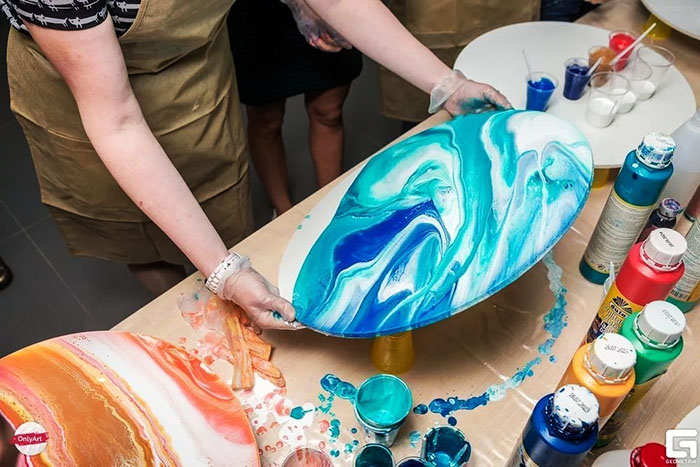
The bases most often used for acrylic painting are presented in the table:
| Warp | Description | Nuances of use |
| Canvas | The simplest option, perfect for beginners. Made from linen and cotton. Can be sold both ready-made - on a stretcher of various sizes, and simply in rolls, like ordinary fabric. | The material can be sold primed or uncoated. In the second case, before starting work, the canvas should be coated with primer and wait for the layer to dry. |
| Cardboard, thick paper for watercolors | Suitable for working in a watercolor style, when acrylic is diluted with water to achieve the desired effect, does not require priming, has a rough, dense texture. | The material is cheaper than canvas, but you need to choose thick paper, because thin paper deforms from water during work. Textured paper must first be glued to a wooden base, then use a spatula to expel the air and let it dry. |
| Wood, plywood | Requires priming for work | The primer is applied in several layers and then left to dry for 24 hours. |
| Glass | Used primarily for stained glass painting | In preparation for work, washing and drying is required. |
Masking tape
Masking tape is used when painting to clearly delineate paint layers and obtain perfectly straight lines.

The material is glued by pressing directly onto the already dried layer of paint or onto the canvas so that the paint cannot leak under it. The tape must be removed carefully and after the paint has completely dried. The tape can also be used to secure the base sheet to the tablet or to create a frame along the edge of the drawing after removing the material.
Easel or tablet
An easel is a special device for ease of work, on which inflexible bases for painting are placed - plywood, wood or canvas on a stretcher. The tablet is used to fix a paper or cardboard base on it.
Art brushes and palette knife for acrylic
To achieve a variety of visual effects in a drawing, you need to have up to 10 artistic brushes of different shapes and bristle thicknesses in your arsenal.
At the initial stage, you should purchase several of the most common tools:
- flat beveled brushes. The tools are designed for drawing small elements or corners;
- flat, short brushes. They are used to create thick, dense and clear strokes;
- Fan brushes. These tools are used to mix colors and blur edges;
- flat brushes. They create thick strokes and paint large areas of the base;
- Round brushes. They are used to apply the main design.
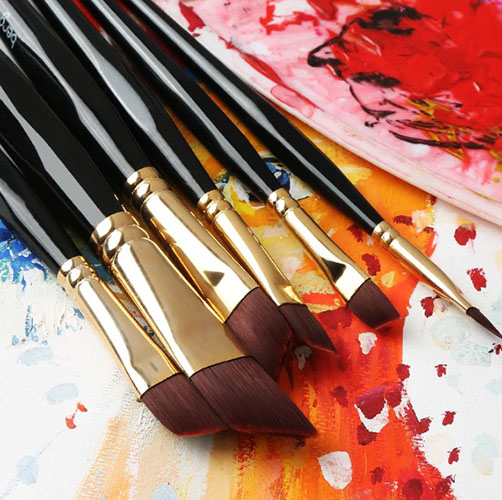
Also, when choosing tools for work, you should consider the material from which the bristles are made. Brushes with a working area made of synthetics, sable or kolinsky of medium hardness are suitable for working in a watercolor style, bristles, synthetics or sable of high hardness are used when working with thick paints, squirrel brushes are used for painting large areas.
It should be taken into account that when painting with acrylic paints, some pressure is applied to the brush, so the tool must be strong and have sufficient length.
A palette knife is a small, elongated, narrow steel spatula; you need to have a tool of different sizes in your arsenal.
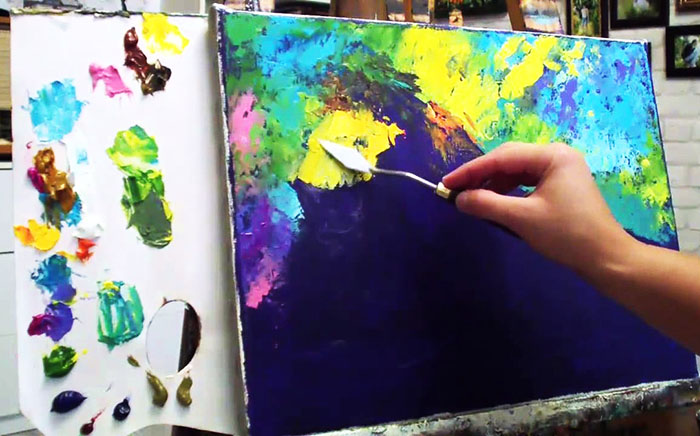
Using a palette knife, perform the following actions:
- mix pigments;
- remove any excess paint that has not dried from the surface of the drawing;
- apply thick strokes of undiluted paint onto the base;
- fill large areas of the design with pigment.
Retarders and mediums for acrylic
Acrylic paints for drawing, which can be used both in thick and diluted form, can be diluted with water or special compounds can be used - mediums and drying retarders. These emulsions make the work much easier, making the paint more pliable, which allows the layer to lie smoothly and maintain color saturation.
With the help of drying retarders, paints can remain in working condition longer, which allows time to correct mistakes in drawing.
Spray
A device with a sprayer is used to spray the surface when painting, which prevents the paint from drying quickly. The sprayer must be filled with cold, clean water.
Color mixing palette
In order to obtain a wide variety of color shades, paints need to be mixed with each other. For this purpose, there is a tool called a palette. It is suitable for use with both oil paints and acrylics.
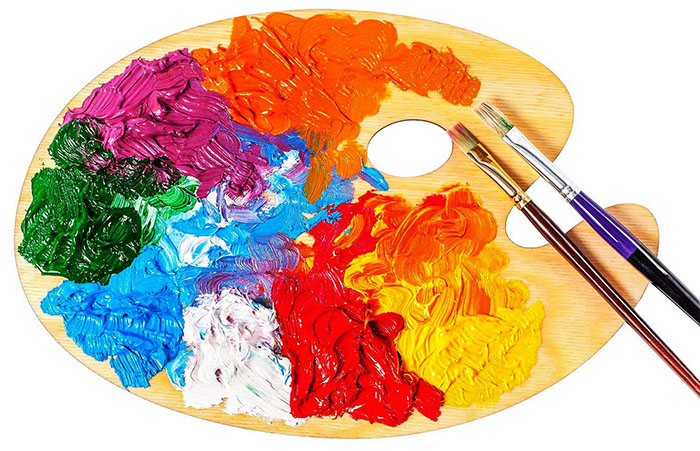
The palette has special recesses in which paints of different colors are laid out. Professionals advise to cover the palette with cling film before use to preserve its original color.
Apron and oilcloth
Although acrylic paints are water-soluble, after they have completely dried they cannot be washed off the surface or fabric, so when starting work, it is best to wear special clothing or have an apron with you.
The work surface is covered with a protective oilcloth.
Water in a jar
In order to pick up a dye of a different color on the brush, it must be thoroughly washed from the previous pigment. Usually, 2 jars of clean water at room temperature are used for this purpose. One is used for the initial washing of paint from the brush, and the second for subsequent rinsing of the tool.
Why and how to dilute acrylic paints?
Acrylic paints for drawing, which can be used both in their original form and diluted, belong to the water-dispersed group. They are based on water, not organic solvents, so the material is well diluted with water and diluted with pigment compositions on the same basis.
Acrylic paints for artistic drawing initially have a thick consistency, so before starting work they need to be diluted with water or a special emulsion.
Most often, dilution is used in the following situations:
- the paint is applied to the base by spraying from a spray gun, in this case it lies on the base evenly;
- if painting work is carried out in a ventilated and warm room, in this case it is necessary to slow down the drying time of the paint layer;
- if dye residue begins to harden while working.
To dilute paints, use emulsions that can be purchased at specialized points of sale. They must be mixed in strict accordance with the manufacturer's instructions.
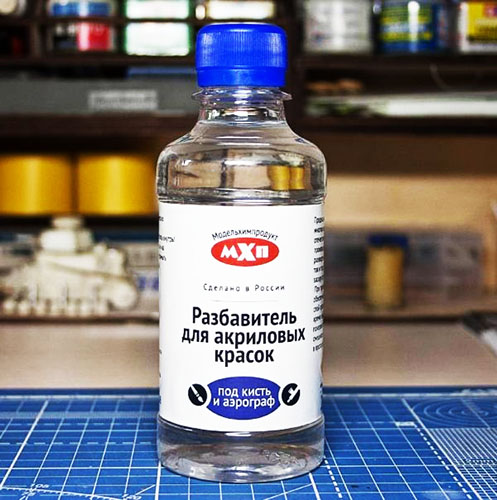
In order to get a good dye after mixing paint with water, you should follow these recommendations:
- the liquid must be distilled, it can be purchased at auto stores or pharmacies;
- if you have to add water from a regular tap, in this case it needs to be left to stand for 24 hours so that the chlorine evaporates and the impurities settle to the bottom;
- The paint must be diluted with liquid until a homogeneous mass is obtained in a separate clean container.
Water must be added in the exact ratio:
- to paint the bottom coat, water is mixed with paint in a 1:1 ratio;
- to obtain a smooth secondary layer, a paint to water ratio of 1:2 is used;
- A translucent layer can be obtained during glazing by mixing water and paint in a ratio of 5:1.
Since water changes the properties of paint, if there is excess liquid, acrylic will not stick to the base, so it is important to follow the dilution recommendations.
How to prepare the base?
If a primed canvas has been purchased for the work, then the preparation will be the fixing of it on the stretcher. The material is ready for use, as it does not need to be sanded or cleaned from dirt. Special paper or cardboard also does not require preliminary processing, the base only needs to be fixed on the tablet with masking tape.

All other surfaces require priming and subsequent finishing. To prepare a canvas or wood base, you need to buy a special primer for acrylic paint. Its composition contains barite with magnesium and calcium carbonate - these components help to form the correct surface texture.
The primer can be applied horizontally or vertically. To apply a very liquid composition, only 1 method is used, in other cases any of the methods will do.
The application of the primer to the base must be carried out in the following sequence:
- First, you need to carefully lay out the base.
- Then you need to pour the primer onto the surface.
- Then you need to quickly spread the composition over the canvas using a rubber spatula or squeegee.
- Smoothing movements must be continued until an even, thin layer is obtained.
- After this, the base should be left to dry.
After applying and drying the primer, the canvas must be secured to the stretcher with staples using a construction stapler.
How to use acrylic paints, features
Acrylic paints for artistic drawing have characteristic differences from student paints - they are produced with a greater variety of shades and have a more saturated tone. They are easy to use, at the initial stage it is recommended to have a set of 7-10 colors.
Artists recommend having the following basic shades with you:
- white;
- green:
- brown:
- pink or purple;
- black.

To learn how to create unique paintings, masters advise following these recommendations:
- using a palette knife or brush, you can mix paints on the palette to get new color combinations and rich shades. When performing this procedure, it will be very helpful to use a color disk, with it it will be easy to understand what color you will get when mixing certain paints;
- adding water will help lighten the paint and give it a watercolor look;
- To change the texture, acrylic paints can be mixed with texture pastes, this will allow you to create and highlight different areas in the painting;
- mixing paints with varnish will create a shine and silkiness effect;
- if you put 2-3 layers of paint on top of each other, you can get an interesting layering effect. Here you need to take into account that each layer needs to be given at least 30 minutes to dry;
- To create a bubbling effect, you need to make blotting or smearing movements with a regular sponge, dipping its corner into the paint;
- An original look can be given to the painting by splashes, which can be obtained by clicking your finger on the end of a brush dipped in paint;
- An abstract drawing is obtained by applying lines with small strokes or dots using the end of the brush, holding it vertically to the base.
A wonderful effect can be achieved by mixing paints not on the palette, but directly on the base in those places where you need to paint a large area, for example, when drawing fields or an autumn forest.
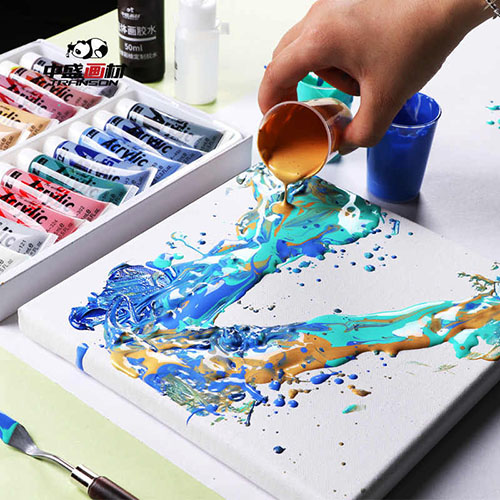
When mixing with water, it is necessary to take into account the fact that the shade of the paint darkens after drying, i.e. it is necessary to dilute the pigment one tone lighter than necessary. It is also possible to achieve lightening of dark paint by adding a white tone.
When painting on canvas, fabric
Special paints labeled as "batik" are suitable for painting on fabric. They are available in a wide range of shades and are durable, flexible, and moisture resistant. Dyed fabric can be washed at temperatures no higher than 60°C.
The paint is applied directly to the fabric, and a fixative is used to separate the color boundaries. This agent is called a reserve and can be made on the basis of gasoline, water or paraffin.
When drawing on a smooth surface, painted walls
Acrylic paints are convenient to use for painting on walls, as they have the following features:
- dry quickly;
- they are environmentally friendly and do not have a harmful effect on the human body;
- wide palette and ease of mixing, which allows you to create any design.
For wall painting, it is better to choose durable paints that form a water-repellent coating - this will allow wet cleaning without damaging the drawing. Before decorating a smooth surface, special attention should be paid to its degreasing.
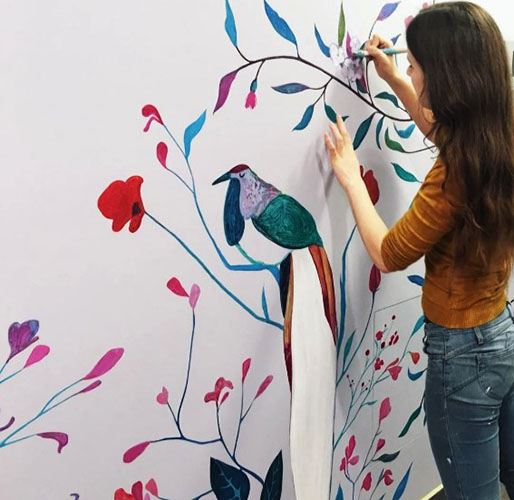
If this is not done, the paint will not hold. The plastic must be treated with an antistatic agent, since dust and fluff can be attracted to it during the painting process, which will ruin the design.
Acrylic paints for wall painting are made on the basis of artificial resins, and the pigment can be either synthetic or natural. Using artificially created pigment, the color of the paints is bright, dense and saturated. If a pigment of natural origin is used, the color of the paints is gentle, soft and has pastel shades.
When drawing on rough, uneven surfaces
Decorating uneven and rough surfaces has the following features:
- Before painting, the area to be treated should be degreased and sanded with fine-grained sandpaper;
- Before applying the drawing, the surface should be covered with a primer, otherwise the image will be uneven;
- if the wood was previously painted, then applying a primer layer is not required;
- An adhesive layer must be applied to the plywood, which will strengthen the adhesion of the paint and the material.
The order of work with acrylic paints, painting techniques
Acrylic paints for drawing, which are easy to use, allow you to convey the mood and the artist's idea well thanks to their brightness and richness.
Creating a drawing consists of several successive stages:
- First, you can apply the general background to the base using the widest flat brush.
- Then, using flat brushes with large numbers, you need to draw the outlines of those large images or objects that you plan to depict. This can be done using matte opaque shades. For example, when drawing a mountain landscape, you should first draw the outlines of the mountain peaks.
- Once the general outlines of the drawing have been applied, you can begin to detail the images using smaller brushes.
- Once the work is finished, it can be varnished.
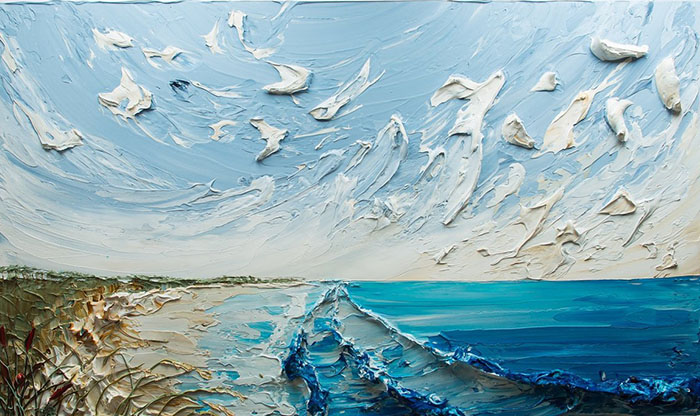
To prevent the paints from drying out too quickly, the image should be sprayed with water using a spray bottle at intervals of 11-13 minutes so that the work is damp, but not wet.
When changing colors, be sure to rinse your brushes in several jars of water, then blot the handle and bristles with a paper towel to remove excess moisture. If you don't do this, drips may form during further painting.
If there are any unwanted paint residues, it is not recommended to flush them down the drain. It is best to wait until they dry completely and then throw them in the trash.
Glaze
When working in this technique, the drawing is formed by layers superimposed on each other. In this case, the paints must be diluted to a translucent state and the previous layer must be completely dried. The more layers are superimposed, the more voluminous, deeper and more expressive the image will be.
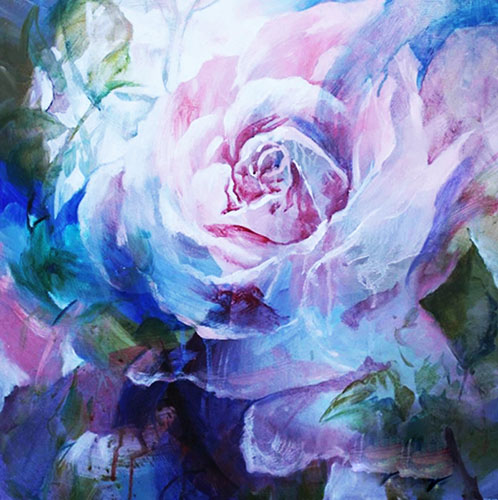
In this technique, the colors do not mix with each other, and additional shades are obtained by layering. A color chart is used to obtain the desired tone. For example, to obtain a green shade, you must first apply a yellow pigment diluted with water, and after it dries, apply diluted blue on top.
"Dry" technique
This technique involves drawing without first wetting the brush with water, for which the dry tool picks up paint and immediately applies it to the base. Therefore, there should be several brushes and after rinsing they are blotted dry. The technique makes it possible to clearly mark color transitions, naturally depict the unevenness of objects.
Imitation watercolor
This technique involves applying paint diluted to a liquid state to a canvas, which is also pre-moistened with a spray bottle. The more the acrylic paints are diluted, the more delicate and transparent the shade will be.
Impasto technique
This technique is similar to impasto painting with oil paints. Layers should be applied with a palette knife or flat brush, which results in thick and textured strokes, which creates a voluminous texture and visual illusion.

It is better to use acrylic paints in tubes for the impasto technique.
How long does it take for acrylic paint to dry?
Acrylic paints dry quite quickly.. Depending on the layer thickness and the ambient temperature, this process can take from half an hour to 2.5 hours or more. If multiple layer techniques are used, each previous layer must be dried before applying the next one for about 30 minutes.
When applying a drawing point-by-point, the work must be dried within 24 hours, while thick, three-dimensional images can dry for up to 48 hours.
How to prevent acrylic from drying out prematurely?
Acrylic paints are a quick-drying material, so they need to be moistened during work to avoid premature drying. To do this, systematically spray with clean water using a sprayer at intervals of 15 minutes.
Applying paint to a previously dried liquid layer
This technique can be used to obtain a permanent base of a given color. Since the dried layer is no longer subject to dissolution, subsequent strokes can be applied on top of it. In this case, an interesting volumetric effect is obtained, and the colors do not mix.
Best acrylic paint manufacturers, cost, colors
There are several manufacturers on the market of artistic acrylic paints.
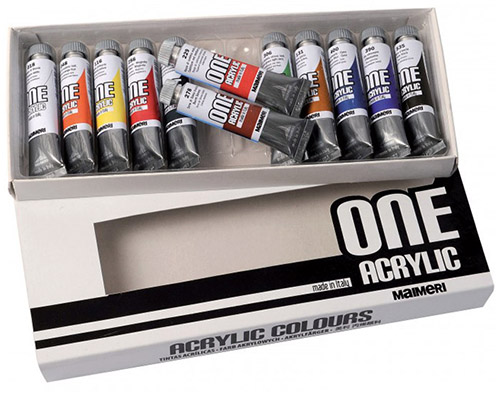
The best of them are the following brands:
- Koh-i-Noor. The paints of this Czech company are distinguished by their pure color and brightness, the palette consists of 10-32 colors. The cost of the set is from 1,200 rubles;
- Lefranc & Bourgeois. Paints of this brand can be applied to any surface, including plasticine and clay, the material has good adhesion. Paints are sold in 75-120 ml bottles or 10-20 ml tubes. The cost of a set of paints in a tube is 1-5,500 rubles, depending on the number of colors. A bottle of single-color paint can be purchased for about 500 rubles;
- Maimeri. This is an Italian brand, which traces its history back to 1923, the palette is represented by several series, the largest one – Maimeri Acrilico – contains 79 stable and long-lasting colors, there are also shades designed to create shine and shimmer. The cost of a 75 ml bottle of paint is 300-400 rubles;
- Ferrari. The brand has been operating since 1919, produces several series of 50 colors, the paints are durable, dry quickly, and do not crack. The bottle volume is 40 ml. Cost is 300 rubles;
- "Gamma". Russian company operating since 1899. The brand's paints have high lightfastness, heat and water resistance, do not fade, and adhere tightly to the base. The paints are sold individually in a 46 ml tube, their cost is 100 rubles, or in a set of 5 colors (each container contains 75 ml of paint), the cost of which is approximately 1,100 rubles;
- "Nevskaya Palitra". This is a Russian factory of artistic paints, producing high-quality products since 1934. The range is represented by sets of paints from 8 colors, tubes have a volume of 18, 46 or 75 ml. Cost - from 500 rubles.
Acrylic paints for drawing are suitable for both experienced and novice artists. They are easy to use, and the availability of various application techniques allows you to create real artistic masterpieces. The paints are presented on the market by a large selection of manufacturers in different price ranges.
Video about acrylic paints for painting
5 mistakes beginners make when painting with acrylics:
